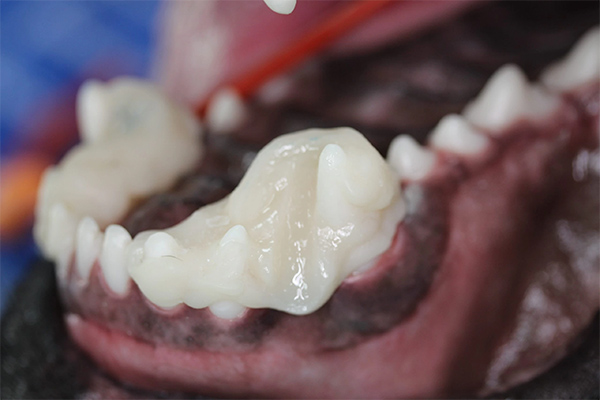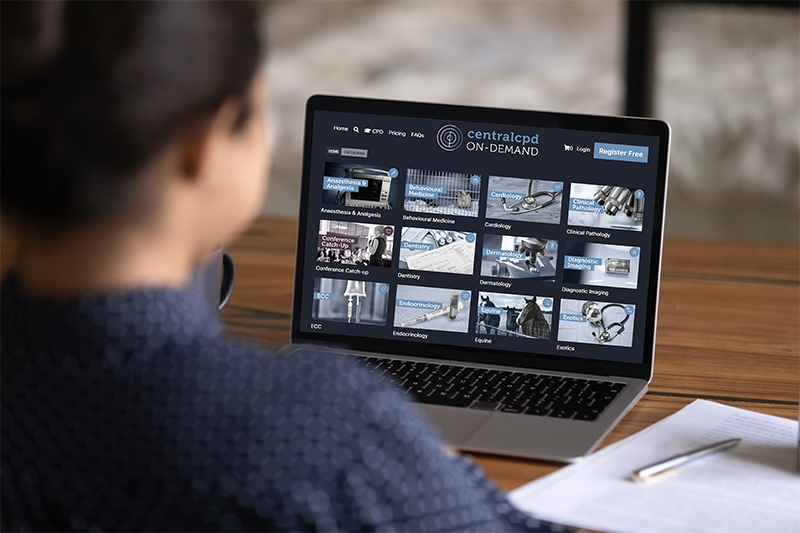Many of us struggle with confidence in echocardiography, often because there’s limited opportunity for hands-on practise until we’re faced with a real patient. And as we all know, pets can be unpredictable – they don’t understand the need to stay still during a scan, and they can easily get distressed, adding to the complexity of the echocardiogram procedure. Different species and breeds bring additional challenges, with variations in heart size, shape, and position requiring us to have a broad, adaptable understanding of cardiac anatomy to get the images we need.
Thankfully, advances in virtual reality training are creating safer, more effective ways for us to learn, benefiting both vets and our patients. VR helps us build motor skills, refine techniques, and master probe orientation for accurate views using real echo images, including those with clinical pathologies, all in a low-pressure, stress-free setting. This kind of immersive practice builds muscle memory, giving us the precision and skill we need to feel confident handling real patients.
VR platforms often provide instant feedback as well, showing the effects of each movement, angle, and probe position. This feedback loop speeds up learning, allowing us to correct mistakes in the moment and build confidence through repetition – without any risk to an animal.
At Central CPD, we’re excited to launch our new Virtual Echocardiography Training Programme, available to hire for use within your practice. The package includes the VR kit for a week, along with tutorials, over five hours of online training, and 20% off our Practical Echocardiography attendance course in Central London. Find out more and book on our website.
Do you dread seeing rabbits in practice? If so, you’re not alone. Despite rabbits being the third most common pet in the UK, we don’t tend to see them as much as dogs and cats, so gaining familiarity with their treatment is more challenging. And as a prey species, they often hide symptoms, so by the time we see them they can be seriously unwell making diagnosis and treatment complicated.
Rabbit Awareness Week falls later on in June, so this month we’ve put together some resources to help you overcome your fears and treat your rabbit patients with confidence! Our ‘how-to’ guides with exotics expert Sonya Miles below cover everything from how to correctly tape in an IV cannula to a step-by-step approach to a difficult rabbit ovariohysterectomy, and our On-Demand portal has a huge range of rabbit related learning series. Or if you want to update your skills in person, why not consider our Surgical Solutions and Emergency Essentials attendance course on Wednesday 8th October?
Rabbit ‘how-to’ guides
How to Give a Subcutaneous Injection in a Rabbit
How to Give Oral Medications to a Rabbit
How to Place an Intravenous Cannula in a Rabbit
How to use an Inhaler with a Rabbit
How to Correctly Apply Rearguard to a Rabbit
How to Use the “Bunny Burrito” Technique to Restrain a Rabbit
How to Trim Rabbits’ Nails
How to Intubate a Rabbit
How to Perform Gentle Physiotherapy in a Rabbit with a Head Tilt
The Post Operative Care of a Partial Ear Canal Ablation and Lateral Bulla Osteotomy in a Rabbit
How to Take a Saphenous Blood Sample in a Rabbit
How to Syringe Feed Rabbits
How to Sex Rabbits
How to Flush Tear Ducts in Rabbits
The Post Operative Care of a Lateral Ear Canal Resection
A Complicated Rabbit Spay
Have you ever felt daunted by that tricky hepatitis diagnosis or stumped by that ‘vague’ case requiring some tricky problem-solving?
Internal medicine in small animals often involves complex conditions affecting multiple organ systems and it can be challenging to diagnose conditions which present late in the disease progression. Plus, in order to treat some conditions, for example, diabetes, acute kidney injury, and DKA, a thorough understanding of a number of different therapies is needed, making it essential to stay up to date with the latest advances in treatments.
As one of the most frequently utilised and important areas in small animal clinics, it’s no wonder then, that internal medicine is one of the most popular fields for general practitioners to specialise in.
And if you’re considering a PGCert as the next step in your career development, the Central CPD PGCert in Small Animal Internal Medicine could be an invaluable asset.
Not only will our PGCert unlock career advancement opportunities, but it’ll also provide a structured pathway to deepen your clinical expertise, improve your diagnostic skills and enhance your treatment plans.
A highlight of the course will be the diagnostic weekend, which will cover practical clinical pathology and haematology as well as advanced diagnostic imaging, giving you confidence with those cases with ambiguous symptoms which can often leave us scratching our heads.
You’ll also benefit from attending in-person sessions on some of the more complex areas such as immunology and infectious diseases, giving you the in depth understanding and expertise to improve patient outcomes and reduce the risk of complications.
With a blended learning approach combining self-paced online training programmes with in-person collaboration and expert-led teaching sessions at our central London venues, you’ll get the best of both worlds in terms of flexibility and one-to-one support.
For full details and enrolment dates, visit www.centralcpd.co.uk/pgcert, or drop us an email at enquiries@centralcpd.co.uk
Many of us feel apprehensive by the idea of performing restorative dental work in-house, and instinctively refer these cases to specialised dental clinics. However, despite the often dauting reputation of advanced dentistry treatment, there’s a compelling case to be made for vets to carry out this kind of work themselves.
Upskilling in new dental techniques can increase confidence and job satisfaction for vets in first opinion clinics, opening up new career opportunities. Plus, investing in training and equipment and being able to offer in-house dental treatments can unlock new revenue streams for practices.
Carrying out restorative dental work in-house also helps to streamline processes, allowing vets to start treatment quickly and reduce overheads, making treatment more affordable for owners. Many clients also appreciate the convenience of having all their pet’s treatment carried out under one roof and by a vet who knows their pet’s medical history and who is familiar – so offering a more holistic approach to healthcare can help increase trust and loyalty to the clinic.
Due to growing interest in restorative and advanced dentistry, and the overwhelmingly positive feedback from last year’s course, we are pleased to announce that our Practical Introduction to Advanced and Restorative Dentistry course will return on 2nd May. This hands-on course will explore new techniques applicable to patient care in general practice. Led by fantastic RCVS Specialist in Veterinary Dentistry Rachel Perry, this highly practical course covers fabricating inclined planes using composite materials to treat certain classes of malocclusion and restorative techniques which can be used on uncomplicated crown fractures and areas of enamel hypoplasia.
This one-day course offers excellent value for money, particularly for Central CPD members, who can join for just £747.50 (+VAT). Find out more at www.centralcpd.co.uk/course/a-practical-introduction-to-advanced-dentistry
As veterinary professionals, we know that keeping abreast of the latest developments in the sector is essential to not only adhere to the RCVS Code of Professional Conduct’s CPD hours requirements, but to also maintain and develop knowledge in a fast-moving industry.
But have you ever been bewildered by the breadth of CPD on offer and struggled to know how to make the most of your budget?
Jennie Mackinlay, Head of Learning and Development at Central CPD, offers some tips to get you started for 2025.
1. Consider your long-term career goals
Think about where you see your career progressing in the short and long-term, and what steps you’ll need to take to achieve your goals. Or if you’re returning to practice, consider a structured programme to expand key knowledge and expertise which can be taken into daily practice as well as support career development. Take a look at our range of Academy programmes and our brand new PGCert programmes (launching later this year) for ideas of training you could undertake.
2. Invest in a mix of online, practical and theoretical learning
With the choice of online and in-person CPD now available to us, it can be easy to stay in your comfort zone. But consider mixing up formats to give you a blend of self-directed learning as well as crucial hands-on practical sessions and more in-depth updates in specialist fields through theory courses. Check out our Membership packages, which offer a blend of free online and theory courses, as well as half price practical sessions all for one simple annual fee.
3. Plan in advance
It’s no secret that practice life can be incredibly hectic, and it can be easy to neglect your CPD until the last minute. But taking some time in January to plan out your learning across the topics that interest you or that you need some extra support in will do wonders for your stress levels at the end of the year! Our On-Demand subscriptions offer personal training plans to help you plan out your CPD and keep track of your learning throughout the year across a range of topics.
4. Reflect on your learning
Reflection is central to outcomes-based CPD and helps you get the most out of your learning. It doesn’t have to be time consuming and could include thinking about if and how you will make changes to how you work or reflecting on a case in practice. Our On-Demand content includes quizzes after each learning series to test your understanding and can be a great way to aid your reflection on what you have learnt.
We also offer the opportunity to progress through from basic to advanced courses in surgery, dentistry and diagnostic imaging, allowing you time for reflection on how to increase knowledge and skills.
If you’d like to find out more about how our membership plans can help you achieve your CPD goals for 2025, take a look at our range of options at www.centralcpd.co.uk/membership or drop us an email at enquiries@centralcpd.co.uk.
In recent years you may have noticed an increase in clients looking for alternative therapies, either alongside or instead of traditional veterinary treatment. While these can be hugely beneficial it’s essential to also weigh up the risks and limitations.
For conditions like arthritis or anxiety, treatments like acupuncture, massage, and hydrotherapy can help alleviate symptoms without the side effects associated with long-term medication.
Many alternative treatments, such as acupuncture or touch therapy, also offer non-invasive and gentler approaches, often appealing to clients who prefer to minimise the use of medication or surgery.
However, while some of these practices have some supporting evidence, other therapies lack substantial scientific backing. Without rigorous evidence, it’s difficult to endorse these options. And as we know, some herbal supplements and nutraceuticals have been proven to be unsafe, interacting negatively with prescribed medications or cause unanticipated side effects.
But perhaps most importantly, alternative therapies can unintentionally delay or detract from more effective treatments, putting animals at risk.
If you’re interested in ways to help you navigate this potential minefield – and perhaps most importantly, steer clients away from unsafe therapies and towards evidence-based treatments, we’re running a brand new course – Veterinary Science: Debunking Myths and Embracing Evidence-Based Practices – on Monday 3rd February 2025 to equip vets with the knowledge to explore alternative therapies and dispel myths.
Veterinary Science: Debunking Myths and Embracing Evidence-Based Practices

Charlie Wright
BSc (Hons) RVN ABTC – AT
This month we’re delighted to introduce a guest blog from RVN Charlie Wright.
Charlie has been working in veterinary environments since 2010, where she has developed a passion for behaviour-centred approaches to all patients.
Since gaining a degree in Animal Behaviour and Welfare, Charlie’s focus has been on working with other veterinary professionals to reduce patient stress. She has spoken at conferences, supported practices rolling out behaviour services, and is now teaching student veterinary nurses.
Charlie is particularly interested in reducing stress in practice, and in 2018, she ran a study to investigate whether providing hospitalised cats with either a box or a partial towel cover to the front of the cage reduced stress levels, and whether each of these methods was sufficient in providing hiding opportunities.
To reduce stress of hospitalised cats, literature advises providing cats with the opportunity to hide using either a box or partially covering the cage front. While studies have found benefits of the box method, there is currently no evidence for the efficacy of the partial cover.
To investigate this, 42 healthy pet cats admitted to a veterinary practice for routine neutering were provided with either a hide box, a partial towel cover to the front of the cage, or neither treatment. Behavioural observations were taken for 60 minutes recording: 1) Kessler and Turner’s Cat Stress Score (CSS), 2) location within the cage, 3) hide seeking behaviour, and 4) use of treatment.
The results showed a significant difference in CSS between cats with a box and the control cats (p=0.007), but not between cats with towel cover and the control cats (p=0.069). There was no significant difference in CSS between box cats and towel cats (p=0.406), but those with a box hid in it 68% of the time, significantly more than the towel cats used the towel (n=30%) (p=0.027). There was a significant difference in hide seeking behaviour between all treatments (p=0.016). A positive correlation was found between CSS and hide seeking behaviour within all groups (rs=0.673), and this was stronger when analysed in control cats only (rs=0.829).
In conclusion, the study suggested that a box provides an opportunity to hide and appears to reduce behavioural signs of stress. Though a partial cover may also help, there is not significant evidence for its efficacy in providing hiding opportunity or reducing stress.
Interested in learning more?
If you’d like to learn more about how to reduce stress in cats and dogs in the clinic, take a look at our Calm Clinic Academy, run by Charlie, which begins in December 2024. This comprehensive year-long programme is designed to equip delegates with tools to reduce fear, anxiety, and stress in patients through subtle practice adjustments. By recognising triggers and stressful situations, we can take steps to prevent the worst-case scenarios, including scarring of the amygdala. Prevention is always better than dealing with the consequences.
Suitable for vets, vet nurses, and practice managers, delegates will learn through a combination of online training programmes, case studies, and two full attendance days, as well as a visit to the London Cat Clinic, a feline-only practice offering gold-standard care to cats to reduce stress and anxiety.
If you’re passionate about reducing fear, anxiety and stress in practice to improve the emotional wellbeing of your patients, this programme is for you!
Featured courses block
Please enter content to generate the block
A study by the RVC highlighted concerning trends in post-covid ‘pandemic puppies’ revealing that canine owners reported an average of five challenging behaviours, with 82% resorting to aversive training methods.
The study, part of the RVC Pandemic Puppies project, focused on dogs purchased during the pandemic, identifying control behaviours, attention-seeking, fear, avoidance, and aggression as common issues. Aversive methods, including shouting and leash corrections, were reported by 80% of owners.
More than 3 million UK households acquired a pet during the pandemic. A combination of owner inexperience, over-zealous breeding and lack of socialisation has created a population of dogs displaying aggression in response to other dogs and humans, many struggling when left home alone, and an increased prevalence of dogs suffering with high arousal levels, poor basic training, and generalised anxiety.
As veterinary professionals, we often find ourselves on the frontline when it comes to dealing with challenging pet behaviour – as well as having the unique opportunity to guide and assist owners in navigating their pet’s behavioural journey.
Our new learning series – Canine Behaviour: Dealing with Post-COVID Problems, explores some of these behaviours, including separation anxiety, reactivity, fear and aggression. Lectured by experienced veterinary behaviourist and co-founder of the Pet Behaviour Company, Miri Prior, we discuss how to manage the patients both in and out of practice and how best to advise owners.
Following recent union strike action advocating for fair pay and better working conditions, as well as the influx of redundancies, the importance of community in our profession is at the forefront of our minds. At Central CPD, we’ve seen first-hand the benefits of CPD in building community and support for veterinary professionals.
Our London-based attendance courses bring together veterinary professionals from around the world, which provide opportunities for networking, sharing experiences, and building relationships. Attending a CPD course on surgical techniques not only enhances your skills but also allows you to connect with peers who share similar interests and challenges.
Our Membership package, which includes free access to all of our theory courses, and half price practical courses, gives vets and nurses even more opportunities to attend these events in person.
We try and help create collaborative learning environments through our Veterinary Academies and 6,000 strong Facebook group as well, where vet professionals can discuss case studies, seek advice, and provide support to one another. These kind of interactions help create a sense of belonging and mutual support within the veterinary community – something which is crucial in the current climate.
Our online learning platform – Central CPD On Demand – also offers opportunities for collaboration and a virtual community. Our Practice Subscriptions enable mentorship roles, allowing for in-practice support where training programmes and resources can be highlighted to team members.
We really believe that CPD can help foster a stronger, more resilient profession by giving vets and nurses support and the ability to share knowledge and build community.
For this reason, we’re offering a 20% discount on many of our online and attendance courses for anyone facing redundancy. Contact us at enquiries@centralcpd.co.uk to find out more. You can also contact VetLife, or consider joining and supporting our veterinary unions, such as the BVA and BVU if you’re struggling with redundancies or unfair conditions in practice.
Last month we were delighted to receive RACE® approval for our On-Demand online CPD portal. This significant milestone reflects our commitment to delivering top-quality content to veterinary professionals.
Let’s delve into what this means for you and why it guarantees an exceptional learning experience…
What is RACE® Approval?
RACE®, the Registry of Approved Continuing Education, is a programme of the American Association of Veterinary State Boards (AAVSB). It sets the standard for veterinary continuing education (CE) programmes, ensuring that they meet rigorous quality criteria.
Why does RACE® approval matter?
RACE® approval means our CPD videos have gone through a stringent review process. This guarantees that the information you receive is accurate, up-to-date, evidence-based and of the highest quality.
As a RACE® approved provider, Central CPD is recognised by veterinary regulatory boards across North America. Many states require RACE® approved CE for license renewal, so by choosing our RACE® approved videos, you can be confident your learning hours will be accepted if you are based in North America.
While RACE® approval is primarily recognised in North America, it also holds significant value for other UK and internationally based veterinary professionals. The RCVS doesn’t require RACE® approval for CPD activities, but this international standard still serves as an indicator of quality, ensuring an enriching and effective learning experience, regardless of geographical location.
With Central CPD’s RACE® approved videos, you are not just meeting your CPD/CE requirements but also investing in your professional growth and the quality of care you provide to your patients.
Find out more about our extensive range of over 2,000 RACE® CPD videos.










